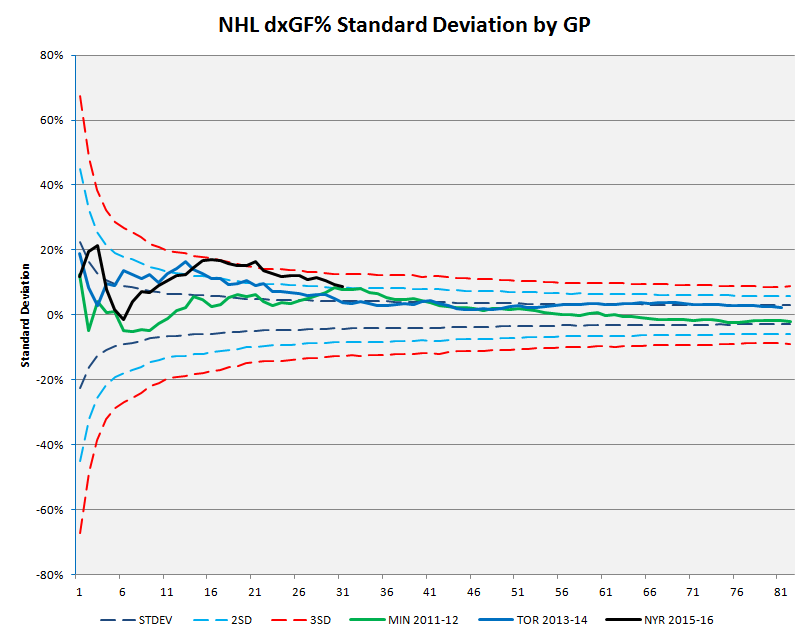Information drives analysis.
The best predictions and decisions require a large enough sample of observations so that we can tease solid signals of information out of the random chaos that we see nightly in NHL games.
Studies of the variation in results in the NHL season have shown that it takes around 73 games before the underlying skill and ability of teams overtakes randomness as the most significant determining factor in the standings. Thus, we know that the earlier in the season we look at the standings, the less reliable or meaningful they are.
We see this every season in the form of the team that rides hot shooting or goaltending early before crashing to earth later on.
Think of the 18-wheeler-over-a-cliff seasons that the Toronto Maple Leafs have endured in recent years, dropping out of a playoff spot to end up in the league basement after the latter two thirds of the season.
Wild fans have gotten to experience both sides of this coin. In 2011-12 they went from 1st in the NHL on Dec. 18 with 45 points through 33 games, all the way down to 24th place with 81 points to close out the year. Last year after 33 games, the Wild sat in 20th in the NHL with 36 points, thanks largely to some of the worst goaltending ever seen in the NHL. They would drop as low as 23rd on Jan. 13, but miraculously they shook Devan Dubnyk loose from Arizona and would end up making the playoffs with 100 points in one of the most remarkable turnarounds in NHL history.
So we know the worm can turn for teams on either side of the ledger in the first third of the season. Curiosity about these turning points and indicators in underlying performance is what has driven much of the progress in the nascent hockey analytics.
Efforts to determine what information is reliable and does provide meaningful indication of future outcomes are the basis for much of the debate and discussion in the field.
One of the most reliable publicly available predictors of future results is Expected Goals For Percentage (xGF%). This is a measure of the probable goal outcomes based upon shot location, type, and shooter devised by Dawson Spriggings using data from War-On-Ice.com.
Using the above-mentioned years of Toronto (2013-14) and Minnesota (2011-12) as examples, we can see how the gap between xGF% and actual GF% – delta xGF% (dxGF%) – narrows as the season progresses. xGF% did a great job of predicting these declines before they actually occurred. If we also look at the New York Rangers of this year, we can see that the slide of their actual GF% towards their xGF% has already begun — and will likely continue for the rest of the year.
If we regress current results to obtain reasonable projections of the remainder of this season, we can get a revised perspective on where teams are likely to end up.
Essentially, we should expect xGF% to regress nine per cent towards average over the remainder of the year, and dXGF% to regress around 45 per cent. By combining the two, we can get a reasonable estimate of how teams are likely to perform over the final 50 or so games. Because predicting shootout and overtime outcomes is virtually impossible given the random nature of the results, all teams have been estimated to split their extra time records 50/50. (Note that this is where much of the unpredictable variation in the standings is likely to occur.)
| METROPOLITAN | GP | reg xGF% | reg GF% | W | L | OTL | PTS | ESTIMATE FINAL PTS | |
|---|---|---|---|---|---|---|---|---|---|
| 1 | WASHINGTON* | 54 | 52.30% | 54.90% | 30 | 18 | 6 | 66 | 108 |
| 2 | NY ISLANDERS* | 51 | 50.10% | 52.80% | 26 | 15 | 10 | 62 | 103 |
| 3 | NY RANGERS* | 51 | 47.50% | 52.20% | 26 | 19 | 7 | 59 | 99 |
| 4 | PITTSBURGH* | 54 | 50.70% | 50.50% | 28 | 18 | 9 | 65 | 98 |
| 5 | NEW JERSEY* | 52 | 48.60% | 49.40% | 26 | 14 | 12 | 64 | 98 |
| 6 | PHILADELPHIA | 52 | 47.70% | 45.20% | 24 | 15 | 13 | 61 | 91 |
| 7 | CAROLINA | 52 | 52.00% | 48.00% | 26 | 18 | 8 | 60 | 88 |
| 8 | COLUMBUS | 51 | 50.70% | 47.30% | 25 | 22 | 4 | 54 | 79 |
In the Metropolitan Division, we can see that the Rangers may have banked enough points that they should still make the playoffs. The scary part for Rangers fans comes when we consider the fact they’re projected to finish just one point ahead of likely Wild Card teams Pittsburgh and New Jersey. In other words, things could be extremely close at the finish line.
| ATLANTIC | GP | reg xGF% | reg GF% | W | L | OTL | PTS | ESTIMATED FINAL PTS | |
|---|---|---|---|---|---|---|---|---|---|
| 1 | MONTRÉAL* | 51 | 52.10% | 55.80% | 29 | 17 | 5 | 63 | 106 |
| 2 | DETROIT* | 52 | 49.80% | 50.10% | 26 | 14 | 12 | 64 | 102 |
| 3 | BOSTON* | 54 | 50.40% | 52.50% | 29 | 20 | 6 | 64 | 99 |
| 4 | OTTAWA | 52 | 47.10% | 49.10% | 25 | 15 | 12 | 62 | 97 |
| 5 | TAMPA BAY | 52 | 50.10% | 50.90% | 27 | 18 | 8 | 62 | 93 |
| 6 | TORONTO | 54 | 53.10% | 49.00% | 27 | 15 | 12 | 66 | 91 |
| 7 | FLORIDA | 52 | 48.00% | 49.20% | 25 | 19 | 8 | 58 | 90 |
| 8 | BUFFALO | 52 | 48.30% | 47.50% | 24 | 21 | 7 | 55 | 82 |
In the Atlantic Division, Toronto represents the other end of the regression spectrum, projected to tie with Washington for the best point total over their final 54 games in the Eastern Conference.
When we factor in the fact that the Leafs have faced the toughest schedule of any NHL team to date and that things are going to get easier in the back half of the year, this makes some more sense.
Despite these realities, Toronto is still probably going to miss the playoffs thanks to their rough stretch of play to open the season that saw them win just one out of their first 10 games.
| CENTRAL | GP | reg xGF% | reg GF% | W | L | OTL | PTS | ESTIMATED FINAL PTS | |
|---|---|---|---|---|---|---|---|---|---|
| 1 | DALLAS* | 52 | 52.50% | 54.60% | 29 | 17 | 6 | 64 | 110 |
| 2 | NASHVILLE* | 52 | 56.50% | 52.70% | 29 | 16 | 7 | 65 | 100 |
| 3 | MINNESOTA* | 54 | 50.70% | 51.60% | 28 | 19 | 7 | 63 | 99 |
| 4 | CHICAGO* | 51 | 50.00% | 51.70% | 26 | 17 | 7 | 59 | 97 |
| 5 | ST. LOUIS* | 51 | 51.10% | 51.00% | 26 | 18 | 7 | 59 | 97 |
| 6 | WINNIPEG | 52 | 47.70% | 47.80% | 24 | 25 | 3 | 51 | 81 |
| 7 | COLORADO | 51 | 47.70% | 48.50% | 24 | 26 | 2 | 50 | 79 |
Nashville looks to be on track in their efforts to down Dallas for top spot in the West.
They’ll have a hard time catching them with the lead the Stars have at this point in the season, though. The Central Division will likely be the class of the Western Conference with five teams in the division approaching 100 points and making the playoffs.
| PACIFIC | GP | reg xGF% | reg GF% | W | L | OTL | PTS | ESTIMATED FINAL PTS | |
|---|---|---|---|---|---|---|---|---|---|
| 1 | LOS ANGELES* | 53 | 52.90% | 53.90% | 29 | 15 | 9 | 67 | 107 |
| 2 | CALGARY* | 53 | 49.90% | 46.10% | 25 | 17 | 11 | 61 | 89 |
| 3 | SAN JOSE* | 53 | 51.60% | 49.90% | 27 | 22 | 5 | 59 | 88 |
| 4 | EDMONTON | 52 | 47.70% | 47.40% | 24 | 20 | 8 | 56 | 84 |
| 5 | ANAHEIM | 53 | 50.40% | 46.50% | 25 | 22 | 6 | 56 | 83 |
| 6 | VANCOUVER | 51 | 47.20% | 47.70% | 24 | 19 | 8 | 52 | 82 |
| 7 | ARIZONA | 52 | 46.20% | 46.20% | 22 | 25 | 4 | 48 | 78 |
The most alarming change for the Western Conference is the obvious decline in quality of the Pacific Division. The Kings are unlikely to repeat as the team that missed the playoffs last season, likely posting the best point total of any NHL team over the final 50+ games of the season. The Kings will probably end the season as the only team in their division on track to top 90 points, with the second- and third-place teams scraping into the playoffs with under 90 points. If that’s the case, they would be the first teams to enter in such a fashion since Montreal and Philadelphia did so with 88 points in 2009-10.








